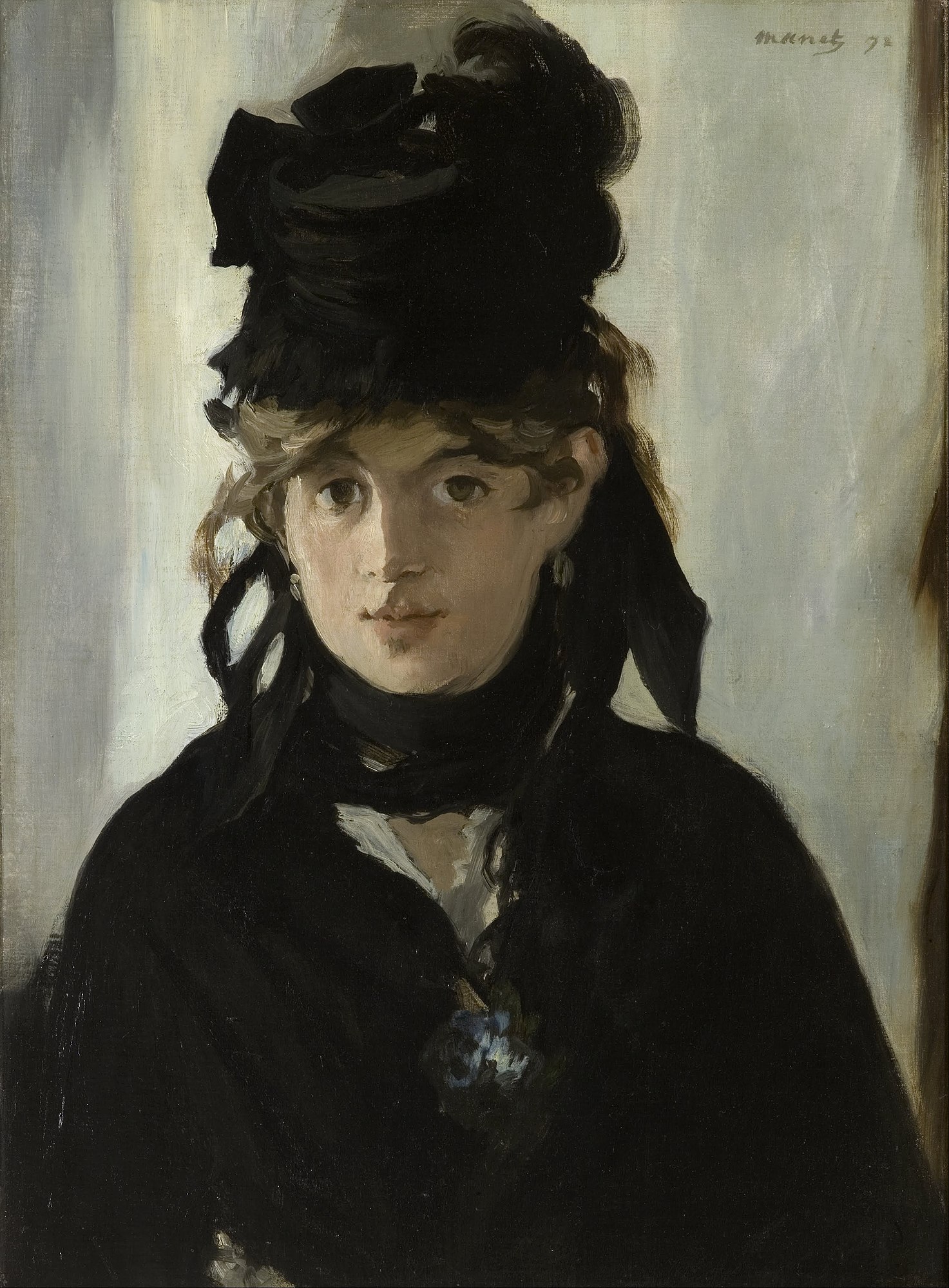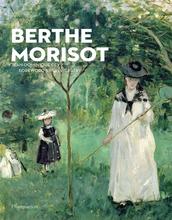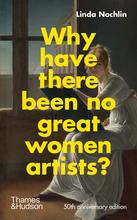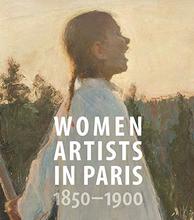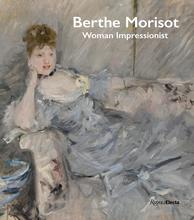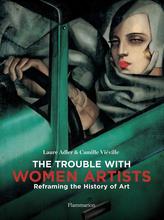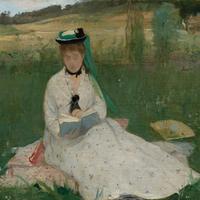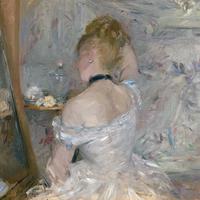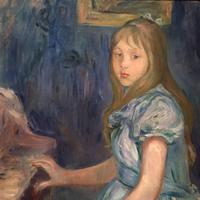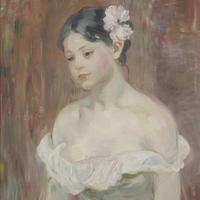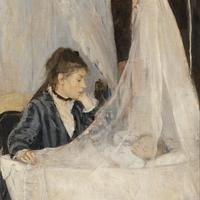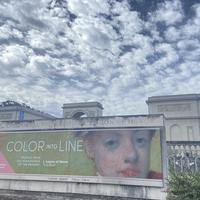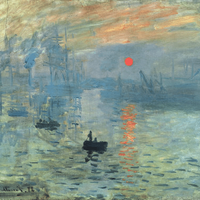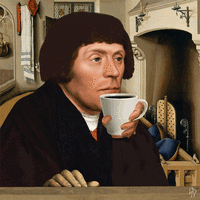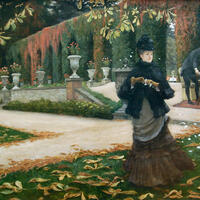More about Berthe Morisot
- All
- Info
- Shop

Contributor
While French custom did its best to isolate, humiliate, and intimidate her in a vain effort to prevent her from displaying her genius, Berthe Morisot pursued her duty as a painter and left a permanent signature on fine art.
A descendant of Fragonard, who was, along with Watteau, essential to the sensibility of pre-Revolutionary France, Morisot grew up attending the Louvre regularly, although her society prevented her from studying art formally. She received a private education in painting (as many young, bourgeois women did) alongside her sister, Edma, but it quickly became clear that she wanted to make painting her profession. While she did not study at the Académie, she was able to register as a copyist at the Louvre, where she studied the work of the old Masters. It was there that she encountered artists like Corot, who encouraged her to paint en plein air (outside), which was still a relatively new concept at the time. Marrying the brother of Édouard Manet, Morisot was also acquainted socially with Degas and many other "Big Men" of French art.
In order to fully understand the extreme repressiveness of French society toward women, you would need to go back to pre-Roman life, in which women held a central political role in a religious order which placed goddesses above gods. Part of the negative attitude toward women comes from the reaction against those roots by the Romans and the subsequent monarchy, which was displaced by Napoleon's Revolutionary government, which itself viewed women as an essentially unfortunate blight which only existed in order to produce the next generation of loyal soldiers.
The excesses of French patriarchy form a theme in the letters between Morisot and her sister Edma. Both sisters began as diligent art students, eventually entering the practice of art on the pretense of doing birthday drawings for their father, a wealthy bourgeois man. Edma, however, did not have the opportunity to pursue a career outside of the home. In the first year of marriage, pregnant and reading books on art recommended by Degas, she wrote, "I'm often with you, my dear Berthe, in spirit; I'm in your studio and I'd like to escape if only for a quarter of an hour to breathe the atmosphere we lived in for so many years." Berthe replied by describing an interaction with Degas in which he laughed at the idea of Edma's reading serious literature and attempted to flirt with Berthe by expounding on the idea "woman is the desolation of the just," which Berthe claimed was a proverb of Shlomo Ha-Melekh, King Solomon, but which is, in fact, based on a contemporary European mistranslation of the text. Of the Proverbs which speak of women, Chapter 31 is famous, as it describes woman as industrious, generous to the poor, creative, and wise. Verse 26 reads, פִּיהָ, פָּתְחָה בְחָכְמָה; ותוֹרַת חֶסֶד, עַל-לְשׁוֹנָהּ "She openeth her mouth with wisdom; and the law of kindness is on her tongue." These are not the same Proverbs Degas was reading!
It is both bizarre and unsurprising that men such as Degas, who were major influences in the life of Morisot, would corrupt, consciously or not, the words of the TaNaKh, the Hebrew Bible, in order to justify their view of women. It is remarkable that Morisot's painter husband was emotionally able to support his wife despite her greater fame and skill, and it is sad that Berthe Morisot replied to her sister Edma to convince her to be complacent with motherhood as an occupation.
Sources
- Bonnet, Marie-Jo. "Un autoportrait de Berthe Morisot." Clio. Femmes, Genre, Histoire (Nov 2006): 1-4, http://journals.openedition.org/clio/1603.
- Clarke, Adam. The Holy Bible Containing the Old and New Testaments: the Text Printed from the Most Correct Copies of the Present Authorized Translation, Including the Marginal Readings and Parallel Texts: Job to Malachi. Cincinnati: H.S. & J. Applegate &
- Duffy, Kevin. Who Were the Celts?: Everything You Ever Wanted to Know about the Celts from 1000 B.C. to the Present. Lyndhurst, NJ: Barnes & Noble Publishing, 1999.
- Duret, Théodore. Manet and the French Impressionists: Pissarro--Claude Monet--Sisley--Renoir--Berthe Morisot--Cézanne--Guillaumin. London: G. Richards, 1910.
- Higonnet, Anne. Berthe Morisot. Berkeley: University of California Press, 1995.
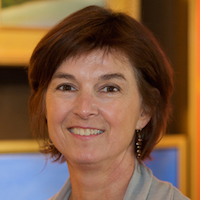
Contributor
Berthe Morisot, who was born January 14, 1841 and died March 2, 1895, came from a wealthy, educated family.
Unlike most women at that time, she was very lucky to have a family that supported her in her painting career. Her family was full of creative people, including the prolific and sometimes erotic painter Fragonard, who was one of her ancestors on her mother's side.
She was very close to her sister Edma, who was also artistically gifted. Edma was often the subject in Berthe’s paintings, and both of them studied with Corot. Women were banned from traditional art schools, and could not paint nudes, or urban street scenes. Both Morisot and Cassatt, although confined to domestic scenes, excelled at what they did.
Morisot became close friends with Édouard Manet, who also became her mentor. Morisot married Eugene Manet, Édouard's brother. She introduced Manet to her circle of friends who became the Impressionists. She also gave Manet tips on painting and influenced him, although few people want to acknowledge that.
Featured Content
Here is what Wikipedia says about Berthe Morisot
Berthe Marie Pauline Morisot (
French: [bɛʁt mɔʁizo]; 14 January 1841 – 2 March 1895) was a French painter, printmaker and a member of the circle of painters in Paris who became known as the Impressionists.
In 1864, Morisot exhibited for the first time in the highly esteemed Salon de Paris, listed as a student of Joseph Guichard and Achille-Francois Oudinot. Her work was selected for exhibition in six subsequent Salons until, in 1874, she joined the "rejected" Impressionists in the first of their own exhibitions (15 April – 15 May 1874), which included Paul Cézanne, Edgar Degas, Claude Monet, Camille Pissarro, Pierre-Auguste Renoir and Alfred Sisley. It was held at the studio of the photographer Nadar. Morisot went on to participate in all but one of the following eight impressionist exhibitions, between 1874 and 1886.
Morisot was married to Eugène Manet, the brother of her friend and colleague Édouard Manet.
She was described by art critic Gustave Geffroy in 1894 as one of "les trois grandes dames" (The three great ladies) of Impressionism alongside Marie Bracquemond and Mary Cassatt.
Check out the full Wikipedia article about Berthe Morisot

